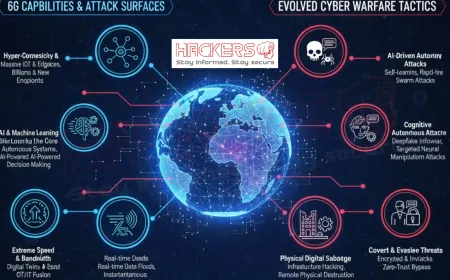How Will 6G Networks Transform Cyber Warfare?
Imagine a battlefield where drones swarm in perfect silence, guided by thoughts from soldiers miles away. Where a single command instantly disables an enemy city’s power grid, water supply, and communications. Where hackers do not steal data, they rewrite reality in real time. This is not a movie. This is the future of war, powered by 6G networks. The next generation of wireless technology is coming around 2030, and it will not just make your phone faster. It will change everything: from how we shop to how nations fight. But with great speed and intelligence comes great danger. 6G will make cyber warfare faster, smarter, and deadlier than ever before. This blog explains, in simple terms, what 6G is, how it works, and why it will redefine conflict in the digital age. The future is wireless. And the next war will be too.

Table of Contents
- Introduction
- What Is 6G and How Is It Different?
- Key Features That Change Everything
- How Militaries Plan to Use 6G
- How 6G Transforms Cyber Warfare
- New Threats Enabled by 6G
- Early Signs and Research
- How to Defend in a 6G World
- The Future of 6G-Powered Conflict
- Conclusion
- Frequently Asked Questions
What Is 6G and How Is It Different?
6G is the sixth generation of mobile networks, following 5G. While 5G brought faster speeds and low latency, 6G goes far beyond. It is not just an upgrade. It is a complete rethink of wireless communication.
- Speed: up to 1 terabyte per second (1000x faster than 5G)
- Latency: under 0.1 milliseconds (near-instant response)
- Frequency: uses terahertz waves (above 100 GHz)
- Intelligence: AI built into the network itself
- Connectivity: trillions of devices, from satellites to brain implants
6G will connect the physical, digital, and biological worlds. Your car, your home, your body, and even your thoughts could be online, all the time.
Key Features That Change Everything
6G is built on five core ideas.
- Terahertz communication: ultra-high bandwidth, short range
- AI-native networks: self-optimizing, self-healing, self-defending
- Network slicing: custom virtual networks for different uses
- Space-air-ground integration: satellites, drones, and ground stations as one
- Sensing and communication fusion: networks that see, hear, and locate
These are not just tech upgrades. They are force multipliers in war and peace.
How Militaries Plan to Use 6G
Defense agencies are already funding 6G research. The U.S., China, EU, and South Korea lead the race.
- Swarm command: control thousands of drones with one signal
- Holographic warfare: real-time 3D battle maps in the field
- Brain-machine interfaces: soldiers think, drones act
- Smart munitions: missiles that reroute mid-flight via AI
- Electronic warfare: jam, spoof, or hijack enemy 6G signals
China’s 6G satellite tests began in 2024. The U.S. DARPA funds AI-driven spectrum sharing. This is not science fiction. It is strategy.
How 6G Transforms Cyber Warfare
Cyber warfare today is about data, disruption, and deception. 6G makes it physical, instant, and intelligent.
- Speed: attacks execute in microseconds
- Scale: one command hits millions of devices
- Precision: target a single soldier’s implant
- Autonomy: AI agents fight without human input
- Integration: cyber and kinetic attacks merge
A 6G-enabled hack is not just a breach. It is a battlefield event.
New Threats Enabled by 6G
6G creates attack surfaces we barely understand.
| Threat | How It Works | Impact |
|---|---|---|
| Terahertz Jamming | Flood high-frequency bands with noise | Blind drones, disable comms |
| AI Agent Sabotage | Poison network AI to misroute or misfire | Friendly fire, wrong targets |
| Slice Hijacking | Take over a military network slice | Full command and control |
| Sensing Attacks | Fake radar or location data | Missiles hit wrong places |
| Neural Hacking | Intercept or alter brain signals | Control soldier actions |
Early Signs and Research
The race is on.
- 2023: China launches first 6G test satellite
- 2024: U.S. funds $100M in 6G defense research
- 2025: EU’s Hexa-X project tests AI-native networks
- Korea: 6G white paper calls it “key to national security”
- Academic papers: over 200 on 6G cyber threats since 2022
A 2024 wargame showed a 6G swarm attack could overwhelm 5G defenses in under 30 seconds.
How to Defend in a 6G World
Old defenses won’t work. New ones are emerging.
- Quantum encryption: unbreakable key exchange
- AI vs. AI: defensive agents counter attackers
- Dynamic slicing: isolate and rotate network segments
- Terahertz firewalls: filter at the physical layer
- Zero trust everywhere: verify every packet, every device
- Space-based redundancy: backup via satellite if ground fails
- International norms: treaties to ban neural weapons
The U.S. DoD now requires 6G security in all new contracts. NATO is drafting 6G defense standards.
The Future of 6G-Powered Conflict
By 2040, 6G will be global. War will look different.
- Hyperwar: battles decided in milliseconds
- Digital twins of battlefields: simulate before fighting
- Autonomous kill chains: AI decides, acts, learns
- Civilian targets: smart cities become weapons
- Peace through deterrence: or escalation?
The line between cyber and kinetic war will vanish. A hacked network could kill as surely as a missile.
Conclusion
6G is not just the next step in mobile tech. It is a revolution in how humans connect, think, and fight. It will bring holographic meetings, instant global control, and life-saving medicine. But it will also bring cyber warfare to a new level: faster, smarter, and more dangerous. With terahertz speeds, AI-native networks, and brain-machine links, a single breach could cripple a nation or start a war. The good news? We are not defenseless. Quantum security, AI guardians, and global cooperation can protect us. But only if we act now. Governments, companies, and citizens must demand 6G be built with security from day one. The future is 6G. Let us make sure it is a future of progress, not destruction.
Frequently Asked Questions
What is 6G?
The sixth-generation mobile network, expected around 2030, with terabit speeds, microsecond latency, and AI built in.
When will 6G arrive?
Commercial rollout begins 2030 to 2035. Testing is already underway in China, the U.S., and Europe.
Is 6G just faster 5G?
No. It uses new frequencies, integrates AI, and connects space, air, and ground as one system.
Can 6G be used in war?
Yes. Militaries want it for drone swarms, holographic command, and instant decision-making.
Will 6G make hacking easier?
Yes and no. More connections mean more targets, but AI security could also be stronger.
What is network slicing?
Creating virtual private networks within the same physical 6G infrastructure, like lanes on a highway.
Can 6G control drones?
Yes. One 6G base station can command thousands of drones in real time with zero lag.
Is 6G safe for health?
Terahertz waves are non-ionizing, but long-term effects are still being studied.
Can 6G be jammed?
Yes. High-frequency signals are fragile. Jamming one band forces fallback to lower ones.
Will 6G replace Wi-Fi?
Not fully. It will complement it, especially for outdoor and mobile use.
Can civilians use military 6G?
Not directly. But dual-use tech will bring benefits like ultra-fast AR and remote surgery.
What is AI-native networking?
AI is not added on. It is part of the core design, optimizing traffic and security automatically.
Can 6G read my thoughts?
Not directly. But with brain-computer interfaces, it could transmit neural signals.
Who is leading 6G development?
China, South Korea, the U.S., EU, and Japan. China launched the first 6G test satellite.
Will 6G need new phones?
Yes. Devices must support terahertz bands and AI processing.
Can 6G be hacked remotely?
Yes. Over-the-air updates, AI models, and slices are all potential entry points.
Is quantum security needed for 6G?
Yes. Future quantum computers could break today’s encryption. 6G must be quantum-ready.
Will 6G increase cyber war?
Likely. Speed and autonomy lower the barrier to attack. But deterrence may rise too.
Can I turn off 6G?
Not easily. Like 5G, it will be in cities, cars, and homes. Opting out means going offline.
How can nations prepare for 6G cyber war?
Invest in AI defense, quantum crypto, red teaming, and international rules of engagement.
What's Your Reaction?


























































